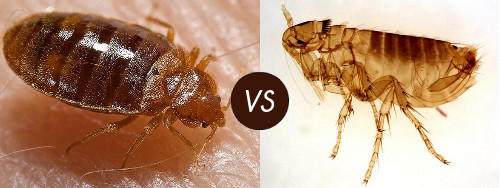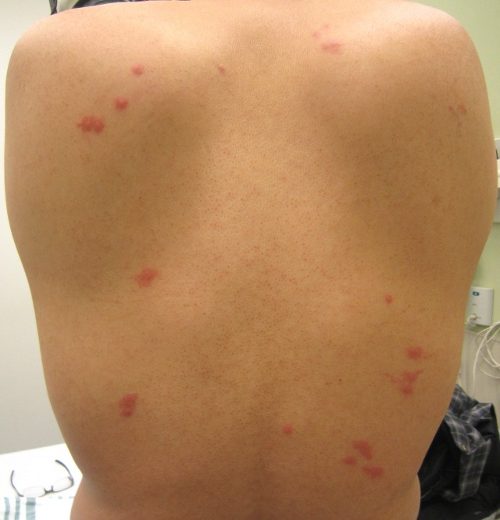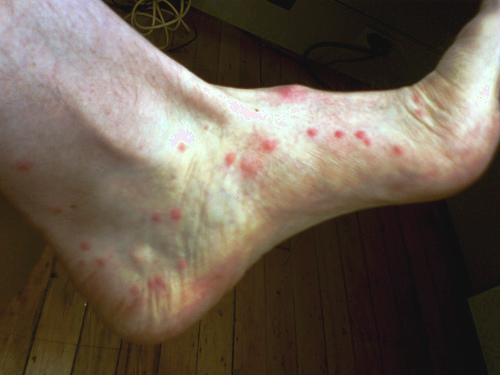
020 3404 5177

Bed bugs and fleas may seem to be similar – they are both unpleasant, tiny, parasitic insects that we would much rather live without – but in reality, there are fundamental differences between the two. Bed bugs are most commonly found in mattresses and furniture or nooks and crannies around the home such as gaps in your bed frame, while fleas inhabit the furry animals in your household and do not feed exclusively on humans as bed bugs do. You can also see the details of how big bed bugs are, compared to fleas.
Controlling an outbreak of fleas in your home is a little bit easier than getting rid of a dreaded bed bug infestation, although both problems can be dealt with using the right equipment and products. Both parasites can potentially transfer diseases, but the chances are low to none. However, bed bugs are severe allergen and can be an additional cause of asthma in children. Depending on which of these creatures has invaded your home, there are different ways to overcome the problem, so it is important to be able to identify which is which. Have a read through the descriptions below so you’ll be able to spot the difference and take the right steps or simply check our post about bed bugs facts and myths – it will help you to differentiate bed bugs and fleas as well.
Bed bugs are flat, oval and are a reddish-brown in colour, and usually measure about 5mm in length, can be compared to ticks in appearance. Like ticks, they appear bigger and darker in colour right after feeding. Nymphs are smaller, paler in colour and look almost transparent.
Bed bugs are usually found hiding in places where people sleep or nap because during that time we release carbon dioxide which attracts them. Such spots may be:


What differentiates bedbug bites from flea bites is the location of the bites and the fact that the bites appear inflamed – red and raised. Bed bugs typically bite any area of skin that is exposed while sleeping. Usually on the back, hands and feet, depending on your sleeping position. The bites themselves are not painful or felt at all, rather they become itchy and can lead to a nasty rash.
They are a little harder to notice than fleas as their bites do not generally hurt, but make it easier by the dark spots on bedding, visible eggs and shed skins they leave behind. They will defecate (poop) processed blood, leaving black stains near their resting place. Bed bugs can lay up to 500 of the eggs every couple of months, so if you do suspect you have bed bugs it is really important to deal with the problem efficiently.
Special bed bugs treatment products are available over the counter, and it is always important to ensure you read the label fully because the affected area is where you sleep. These bugs can also survive up to 18 months without feeding. If you do not feel comfortable tackling your bed bug problem yourself or have any safety concerns, the qualified and experienced professionals at Panther Pest Control have all the knowledge and industrial materials required to get rid of bed bugs effectively and efficiently.
Fleas are wingless parasitic insects often between 2-3 mm in length, dark-coloured with flattened bodies and long legs for better jumping. Fleas are the second best jumpers (relative to size) in the animal kingdom, being able to jump vertically up to 7 inches and horizontally up to 13 inches.
Unlike bed bugs, which feed exclusively on humans, fleas feed and live on almost exclusively on hairy mammals, such as cats, dogs and other furry human companions. Their habitat is hair, as their bodies are specially adapted to moving quickly around the hair. However, although they live in animals’ fur, they can lay their eggs everywhere and for expeditious time – up to 50 eggs per day.
Unlike the ghostly bedbug bites, flea bites are very much felt in the moment of biting. Sudden discomfort, followed by itchiness can sum up the typical flea bite experience. In addition, flea bites remind of mosquito rather the bedbug bites, due to the distinctive red spot in the centre. Flea bites are generally harmless in a long-term context, causing mostly discomfort or a rash in heavier cases of infestation. However, in other contexts fleas, bites may be dangerous because these parasites can be a vector for diseases in dangerous locations or during epidemics.

Rather difficult to spot are these pesky parasites, as they don’t have a usual hiding place except on their host. The first step is inspecting the coat of you companion animal. If you find physical evidence of fleas, you should immediately take your pet to the vet in order to get a proper anti-flea treatment, preferably one with a long-term effect. If you do not have any animals at home, but you think you have fleas you must seek professional pest control help.Fleas are often between 2 and 3mm in length, and their mouths are designed for piercing flesh. Also, have in mind that fleas can jump of up to 13 inches. A flea problem can escalate very quickly, so like bed bugs, it’s best to find a solution to the problem as soon as you have noticed it arise. Fleas can make the life of an animal very uncomfortable, so treating your pet immediately is important. But so is treating your surroundings as fleas have been known to survive for months without a host. As with bed bugs and other pests, you can either use treatment from a chemist or vet or again get in touch with our pest control professionals so you can be sure the infestation is behind you.
Disinfection helps to reduce the risk of illnesses associated with infestations and with the pest treatments. The majority of pests carry bacteria and viruses which pose serious health risks to people and pets. Specialised cleaning agents help for the removal of up to 99.99% of ALL harmful pathogens such as Norovirus, Swine Flu, E.Coli, Salmonella, Legionella and many more that are brought by rodents, birds and insects.
These pathogens can easily be spread throughout premises through poor hand hygiene, contact with urine or faeces or consumption of contaminated food or water.